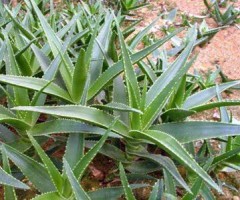ALOE, CHARACTERISTICS AND HEALING PROPERTIES
Supplements Aloe Vera

The genus Aloe belongs to the family of Aloeaceae and includes many species from Africa and Arabia.
These are evergreen plants, some of which are devoid of stem with leaves arranged in a rosette, with the other keg high, simple or branched. The flowers are formed on the top of a long stem, inflorescence with umbrella, pendant, tubular, pale reddish, orange or yellow.
Are self-sterile plants that is to say that the male and female flowers on the same plant can not cross each other or with plants of the same variety, different varieties of plants are needed in order to obtain fertile seeds. We therefore reproduce for cross-pollination. A feature of these plants is that in the parenchyma of the leaves is present a juice aromatic, very bitter which in contact with the air it hardens and is insoluble in alcohol widely used for its therapeutic properties.
In Europe, it is grown mainly in Spain
.
The use of aloe is very ancient, as evidenced by the cuneiform text of some clay tablets found in the Mesopotamian city of Nippur, Iraq, and dated to around 2000 BC the Assyrians were therefore the first users of Aloe Vera. There were many ancient peoples who used it for healing purposes.
The systematic study of this plant, however, began only in 1959, thanks to a pharmacist Texan, Bill Coats, who devised a process for stabilizing the pulp pioneering the marketing of aloe without problems of oxidation and fermentation. At the same time the U.S. government officially declared the healing properties of this plant. Since then, studies sull'Aloe are very active throughout the world.
The healing properties of aloe are numerous and can be summarized as follows:
- Regenerating: stimulates the growth of the epithelium in the wounds;
- Proteolytic and healing: dissolves and absorbs the enzymatically dead or damaged cells, stimulating the regeneration process;
- Anti-inflammatory: accompanies and helps to overcome the inflammatory process;
- Antipyretic: relieves burning from sunburn, inflammation and fever;
- Humectant: is moisturizing, favoring the retention of water in the tissues of the skin;
- Analgesic: it gives pain relief, even in depth;
- Fungicides: inhibits the growth of fungi;
- Virostatica: hampers the growth of the virus;
- Bacteriostatic: inhibits the growth of bacteria;
- Hemostasis: reduces bleeding lesions;
- Antipruritic: relieves the itching;
- Detoxifying: helps detoxify the body of impurities of toxins;
- Anticancer properties (see also Aloe arborescens)
Supplements Aloe Vera
